
Notodontidae is a family of moths with approximately 3,800 known species. The family was described by James Francis Stephens in 1829. Moths of this family are found in all parts of the world, but they are most concentrated in tropical areas, especially in the New World. The Thaumetopoeidae are sometimes included here as a subfamily.

The codling moth is a member of the Lepidopteran family Tortricidae. They are major pests to agricultural crops, mainly fruits such as apples and pears. Because the larvae are not able to feed on leaves, they are highly dependent on fruits as a food source and thus have a significant impact on crops. The caterpillars bore into fruit and stop it from growing, which leads to premature ripening. Various means of control, including chemical, biological, and preventive, have been implemented. This moth has a widespread distribution, being found on six continents. Adaptive behavior such as diapause and multiple generations per breeding season have allowed this moth to persist even during years of bad climatic conditions.

Manduca quinquemaculata, the five-spotted hawkmoth, is a brown and gray hawk moth of the family Sphingidae. The caterpillar, often referred to as the tomato hornworm, can be a major pest in gardens; they get their name from a dark projection on their posterior end and their use of tomatoes as host plants. Tomato hornworms are closely related to the tobacco hornworm Manduca sexta. This confusion arises because caterpillars of both species have similar morphologies and feed on the foliage of various plants from the family Solanaceae, so either species can be found on tobacco or tomato leaves. Because of this, the plant on which the caterpillar is found does not indicate its species.
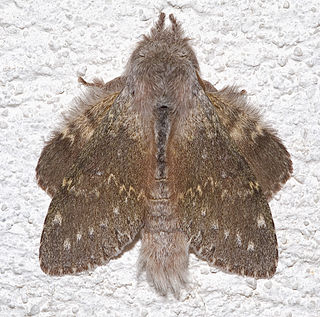
The lobster moth, also known as lobster prominent, is a moth from the family Notodontidae. The species was first described by Carl Linnaeus in his 1758 10th edition of Systema Naturae. The English name refers to the crustacean-like appearance of the caterpillar.

Acleris variegana, the garden rose tortricid moth or fruit tortricid, is a moth of the family Tortricidae. It has a Palaearctic distribution. The moth flies from July to September mainly at night and is attracted to bright lights. The larvae feed on various trees and shrubs including rose and apple.

Ochrogaster lunifer, the bag-shelter moth or processionary caterpillar, is a member of the family Thaumetopoeidae. The species was first described by Gottlieb August Wilhelm Herrich-Schäffer in 1855. Both the larval and adult forms have hairs that cause irritation of the skin (urticaria). The adult moth has a woolly appearance and its wings can grow to be about 5.5 cm across. The larvae feed on Grevillea striata at night and reside in brown silken bag nest during the day.

Hylaeora eucalypti is a moth of the family Notodontidae. It is found in the southern half of Australia, including the Australian states of South Australia, Victoria, New South Wales and Tasmania.
Heliothis subflexa is a moth of the family Noctuidae first described by Achille Guenée in 1852. It is found from most of the United States, throughout the Antilles, and south to Argentina.

Datana contracta, the contracted datana, is a moth of the family Notodontidae. It is found from Maine to Florida west to Arkansas and Wisconsin.

Datana integerrima, the walnut caterpillar moth, is a moth of the family Notodontidae. It is found in eastern North America, from Ontario, through most of the Eastern States west to Minnesota and south to northern Mexico.
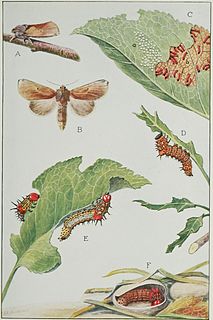
Schizura concinna, the red-humped caterpillar, is a moth of the family Notodontidae. It is found from southern Canada to Florida and California.

Phryganidia californica, the California oakworm or California oak moth, is a moth of the family Notodontidae. The species was first described by Alpheus Spring Packard in 1864. It is found along the coasts of the US states of California and Oregon.
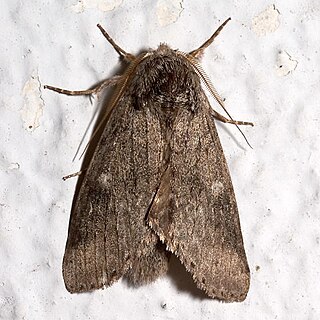
Lochmaeus manteo, the variable oakleaf caterpillar moth, is a moth of the family Notodontidae. It is found in eastern North America.
Datana is a genus of moths of the family Notodontidae. The genus was erected by Francis Walker in 1855.

Misogada is a monotypic moth genus of the family Notodontidae erected by Francis Walker in 1865. Its only species, Misogada unicolor, the drab prominent, was first described by Alpheus Spring Packard in 1864. It is found in North America from Nova Scotia to Florida, west to Texas and north to Saskatchewan.

Datana ministra, the yellownecked caterpillar, is a moth of the family Notodontidae. It is found in southern Canada and the United States east of the Rocky Mountains, in the south-west it ranges to California.
Oligocentria lignicolor, the white-streaked prominent moth or lacecapped caterpillar, is a moth of the family Notodontidae. It is found in North America, including Connecticut, Georgia, Illinois, Louisiana, Massachusetts, Mississippi, Missouri, New Brunswick, New Jersey, New York, North Carolina, Oklahoma and Pennsylvania.
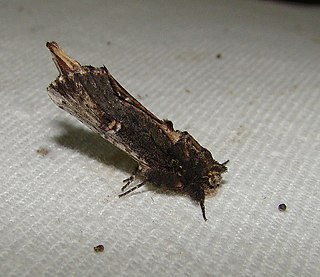
Schizura ipomoeae, the morning-glory prominent moth or false unicorn caterpillar, is a moth of the family Notodontidae. It is found in the United States and southern Canada.
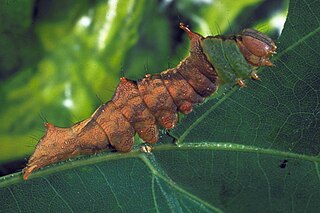
Schizura unicornis, the unicorn caterpillar moth, unicorn prominent or variegated prominent, is a species of moth of the family Notodontidae. The species was first described by James Edward Smith in 1797. It is found in all of North America, except the arctic north.


















